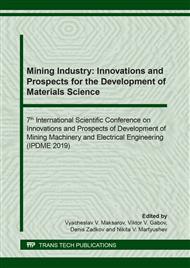p.1
p.6
p.13
p.19
p.25
p.36
p.41
p.46
Determination of the Conditions of an Effective Functioning of Elongated Cumulative Charges in Processing the Marble Stone
Abstract:
The study of the effect of Elongated Cumulative Charges (ECC) on rock formations has an important scientific and practical significance for solving a number of process problems in mining practice. The use of charges with a longitudinal concavity for a directional destruction (presplit blasting, “smoothwall” chipping) involves reducing the explosives consumption, preserving the aquifer rock mass from additional explosion-caused cracks, obtaining a smooth contour and reducing the volume of drilling works. It is noted that one of the options that provides the explosion energy redistribution in a destructible medium is the use of elongated cumulative charges with a damping core. Experimental evidences on the dynamic loading of model blocks by an explosion of an elongated cumulative charge with an inert pad of various acoustic stiffness are reported.
Info:
Periodical:
Pages:
19-24
Citation:
Online since:
March 2020
Authors:
Price:
Сopyright:
© 2020 Trans Tech Publications Ltd. All Rights Reserved
Share:
Citation:


